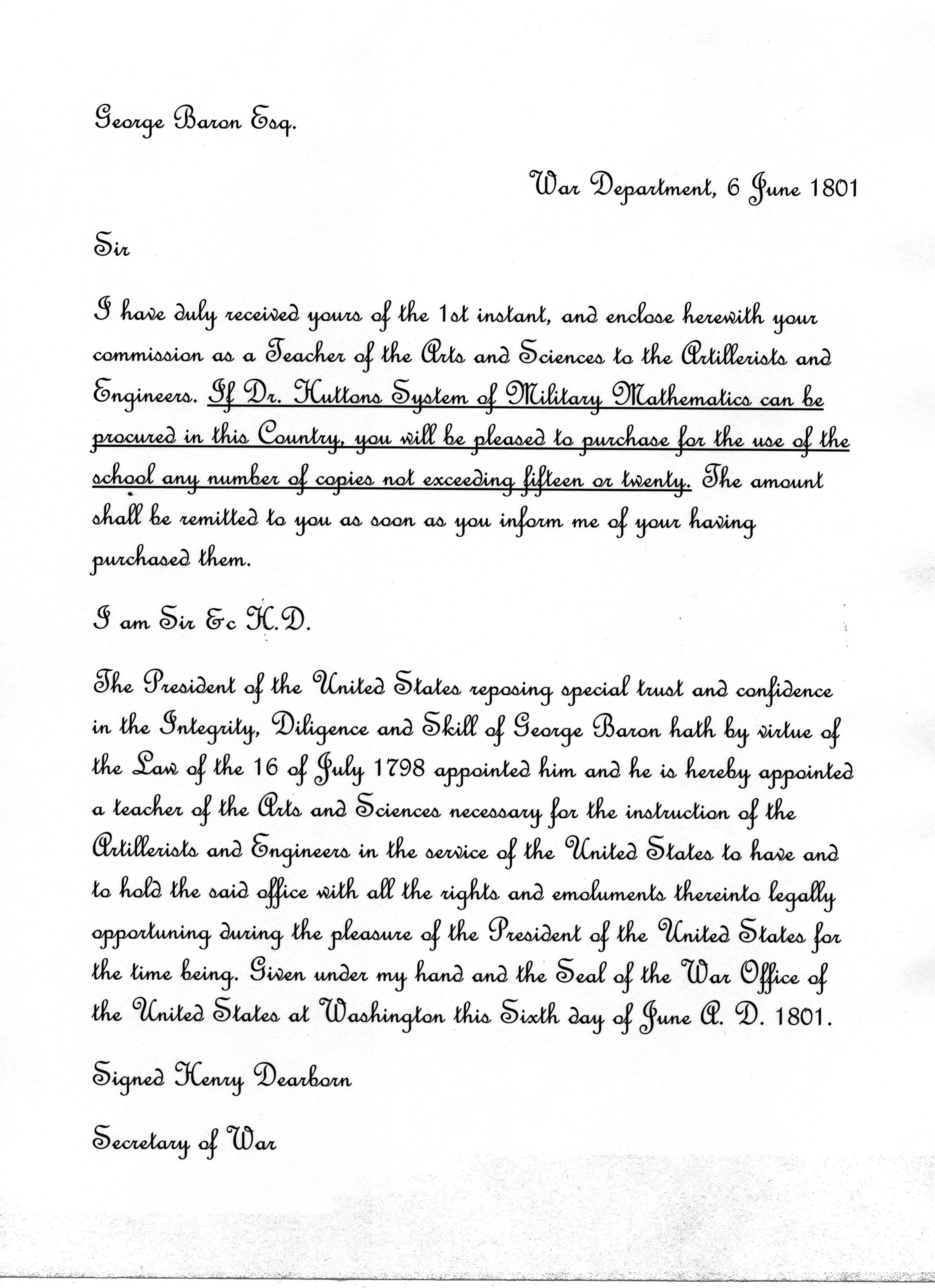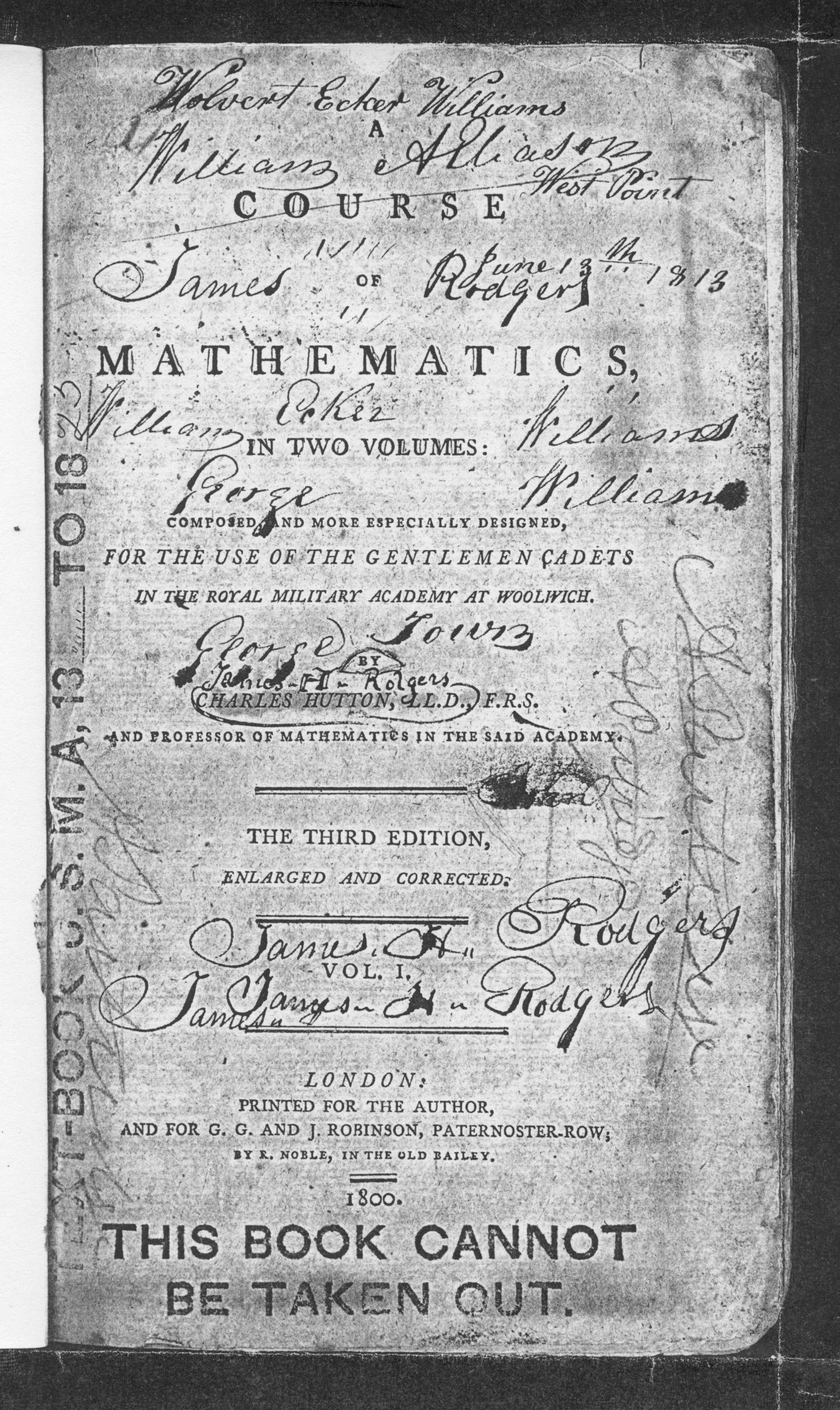- About MAA
- Membership
- MAA Publications
- Periodicals
- Blogs
- MAA Book Series
- MAA Press (an imprint of the AMS)
- MAA Notes
- MAA Reviews
- Mathematical Communication
- Information for Libraries
- Author Resources
- Advertise with MAA
- Meetings
- Competitions
- Programs
- Communities
- MAA Sections
- SIGMAA
- MAA Connect
- Students
- MAA Awards
- Awards Booklets
- Writing Awards
- Teaching Awards
- Service Awards
- Research Awards
- Lecture Awards
- Putnam Competition Individual and Team Winners
- D. E. Shaw Group AMC 8 Awards & Certificates
- Maryam Mirzakhani AMC 10 A Awards & Certificates
- Two Sigma AMC 10 B Awards & Certificates
- Jane Street AMC 12 A Awards & Certificates
- Akamai AMC 12 B Awards & Certificates
- High School Teachers
- News
You are here
Mathematics Education at West Point: The First Hundred Years - The Founding of the Academy
Although the United States Military Academy was officially established by an Act of Congress and signed into law by Thomas Jefferson on 16 March 1802, its evolution and birth go back a quarter of a century to 1776 when George Washington, the father of the United States, Henry Knox, his Chief of Artillery, and Alexander Hamilton, then an artillery officer, saw the need for an academy to train military engineers.
On 20 June 1776, Congress passed an act forming a “Corps of Invalids” (disabled veterans) that were to be taught by officers in their spare time. It declared that
When off duty, [the invalids] shall be obliged to attend a mathematical school, appointed for the purpose, to learn geometry, arithmetic, vulgar and decimal fractions, and the extractions of roots.[1]
This training took place at the strategic Revolutionary War fort at West Point, on the Hudson River, fifty miles north of New York City. Located at a tight S-curve in the river, West Point was essential to the revolutionary forces. If the British occupied West Point, they gained control of the Hudson River, thus effectively cutting the colonies in half. The Commanding General of West Point became infamous when he tried to deliver the plans for West Point into British hands. The General in question?—Benedict Arnold. Besides studying mathematics, the officers were also obliged to contribute one day’s pay per month to procure a regimental library. Thus began the oldest government library in the country (the Library of Congress was not founded until 1800). It is unclear what became of this library. Perhaps a few of its volumes survive in the present USMA library, but no evidence for this has yet been found.
Between 1784 and 1794, West Point was occupied by a single company of soldiers whose primary activity was maintaining the decaying fortifications. Then, in 1794, a Corps of Artillerymen and Engineers was created at West Point. In March of 1796, fire claimed the only structure suitable for indoor instruction and classes were suspended. They did not resume on a regular basis until July 2, 1801 with the ordering of cadets to West Point by Secretary of War, Henry Dearborn.
In May of 1802, plans were drawn for the Academy, which was to cost $1,500 for the construction of a mathematics room, a drafting room, quarters for the cadets, two mess rooms, and quarters for the officers, teachers, surgeon and their families. The early curriculum consisted of the rudiments of mathematics and military fortification. Some newly arriving cadets could not read or write, while most had only a basic knowledge of arithmetic and grammar. Unlike the French and English military, Jefferson’s view of the Academy was in keeping with his strong republican (the Republican Party of that time was more akin to the current Democratic Party) leanings, the Academy should be open to young men of all backgrounds, not just the affluent. Thus the admission requirements had to be at a level to allow those from rural backgrounds admission.[2] The admissions requirements were kept at a low level for most of the 19th century. In addition, it was only required that officers of the day have the most basic, practical understanding of mathematics to lay artillery correctly, to construct simple fortifications and to draw rough maps.[3]
Five weeks after Thomas Jefferson became president, his Secretary of War, Henry Dearborn, wrote to George Baron, a friend from the District of Maine, to ask if he was interested in a position as teacher of mathematics at an annual salary of about $700. “West Point on the Hudson,” Dearborn wrote, “will probably be the position for the school.” For the first decade or so of the Academy’s existence, there was strong lobbying, both in Washington and by some of the early Superintendents, to move the Academy to the Capital, Washington City (later Washington D.C.). Baron bickered over the salary, but after Dearborn pointed out that it was fixed by Congress, and offered several perks including a house, twelve to eighteen cords of firewood, and a place to summer his cow, they came to agreement. On June 6, 1801, Dearborn sent Baron his commission as "Teacher of the Arts and Sciences to the Artillerists and Engineers.” Dearborn also requested that Baron purchase[4] "any number of copies not exceeding fifteen or twenty" of Charles Hutton's A Course in Mathematics for use at West Point. It is interesting that the choice of the first textbook at West Point was not left to the “Gentleman well skilled in the mathematics” but was dictated by those in Washington City.[5]

Dearborn's letter to Baron

Title Page of Hutton's Course of Mathematics
Of Baron we know very little. He was born in England in 1769, and taught school there (but not at the Royal Military Academy at Woolich as is often stated) before immigrating to Hallowell, a small town in southern Maine some five miles from where Henry Dearborn lived.[6]
The first mathematics lesson at West Point — indeed, the first lesson in any subject — was taught by George Baron on 21 September 1801, six months before the Academy was legally founded. He used a “standing slate” to teach algebra to a few cadets, this being the first recorded use of the blackboard in the United States.[7] When Joseph G. Swift, who became the first graduate of West Point, arrived on October 14, 1801, Baron furnished him with a copy of Hutton’s Course and “a specimen of his mode of teaching at the blackboard in the academy.” Soon thereafter, Baron and Swift got in a shouting match involving “coarse epithets” and Baron was, for a variety of reasons, court-martialed and fired. “His name was set upon the public buildings as a disgraced officer.”[8] Thus ended the short career of the zero'th professor of mathematics at West Point. After leaving West Point, Baron moved to New York City where he taught school and founded The Mathematical Correspondent, the first mathematics periodical published in the United States.[9] It survived for only one volume, partly because of the acerbic personality of Baron.
[1]Florian Cajori, The Teaching and History of Mathematics in the United States, Washington, Government Printing Office, 1890.
[2]The first written entrance requirements that we have found are from 1810. See the section of this article titled "Sylvanus Thayer and the 'New' Academy.”
[4] All images courtesy of the USMA Library Archives.
[5]Dearborn to Baron, April 11, May 11, and June 6, 1801. Miscellaneous Letters Sent, Secretary of War, M370, RG 107, NA. We would like to thank Theodore J. Crackel for providing copies of these letters.
[6]Theodore J. Crackel, West Point: A Bicentennial History, Lawrence: University Press of Kansas, 2002, pp. 308-9. The statement that Baron did not teach at Woolich is based on Crackel’s examination of the list of faculty who taught at Woolich in "The Shop;" The Story of the Royal Military Academy, by F. G. Guggisberg, London and New York: Cassell and Company, limited, 1900. The date of Baron’s birth is known from a portrait that was distributed with the eighth issue of The Mathematical Correspondent, but it exists today only in some copies, e.g., that at American University. The copy on microfilm in the American Periodical Series II, reel 26, does not have the portrait.
[7]Joe Albree, David C. Arney, and V. Frederick Rickey, A Station Favorable to the Pursuits of Science: Primary Materials in the History of Mathematics at the United States Military Academy. Providence: American Mathematical Society and London: London Mathematical Society, 2000, p. 11.
[8]The Memoirs of Gen. Joseph Gardner Swift, LL.D., U.S.A., First Graduate of the United States Military Academy, West Point, Chief Engineer U.S.A. from 1812 to 1818: 1800-1865: to Which is Added a Genealogy of the Family of Thomas Swift of Dorchester, Mass., 1634 by Harrison Ellery. Worcester, MA: F.S. Blanchard & Co., 1890. See pages 27-28, 31.
[9]Edward R. Hogan, “George Baron and the Mathematical Correspondent,” Historia Mathematica, 3 (1976), 403-415.
Editor's note: This article was published in May of 2008.
V. Frederick Rickey and Amy Shell-Gellasch, "Mathematics Education at West Point: The First Hundred Years - The Founding of the Academy," Convergence (July 2010)




